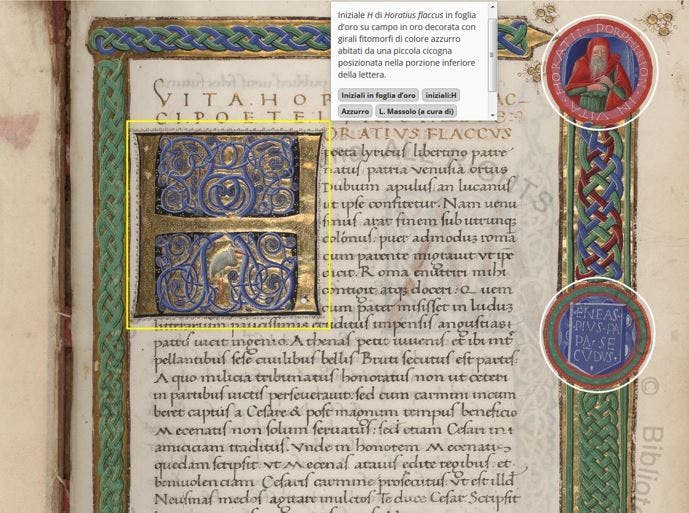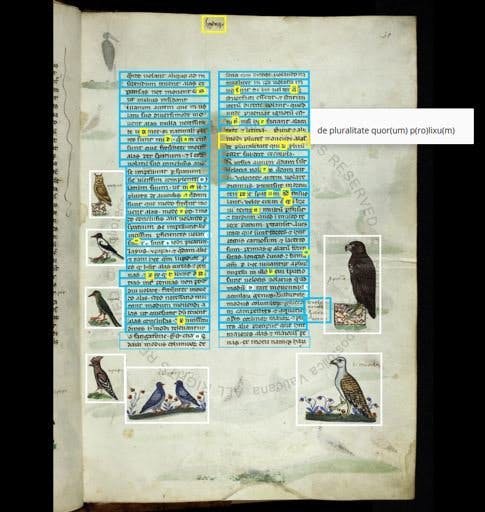The Vatican Library goes beyond digitization to deepen access to 300 rare manuscripts

Stanford, CA—The Vatican Library (the Biblioteca Apostolica Vaticana) recently launched Thematic Pathways on the Web, which drastically expands the traditional functionality of most digital libraries by offering narratives and over 26,000 annotations for exemplary manuscripts in its collection. The site was designed to engage serious scholars as well as pique the interest of individuals with a desire to learn more about these treasured items. Thematic Pathways proves the point that digitization helps transform access to primary source materials, and thus research more broadly, by breaking down the physical barriers to many unique objects, adding functional possibilities for scholars not available when working directly with original copies.
The site is the result of a three-year project funded by The Andrew W. Mellon Foundation with the Vatican Library serving as the principal investigator and Stanford Libraries serving as the technical partner for the project. Thematic Pathways uses Stanford’s platforms as a foundation, including the International Image Interoperability Framework (IIIF), a set of image standards established by Stanford Libraries, the Bodleian Libraries at Oxford University and the British Library among others. Thematic Pathways also employs Stanford’s Mirador image viewer to enable annotation and transcription in addition to its many other functions to deepen scholarly engagement with digital objects.
“The need to tell stories is in the nature of man. Primarily, this is because telling is telling about oneself. The narrator takes what he tells of the experience and turns it into an experience for those who listen to his story,” said His Eminence José Tolentino Cardinal de Mendonça, Archivist and Librarian of the Holy Roman Church. “The same happens in this innovative project: the Thematic Pathways of the Library tells stories that are intertwined in the Vatican manuscripts, from which the many voices contained in them are revealed. And from these tracks, recorded through the Mirador tools relying upon IIIF, we get new knowledge that is exposed on the web for the common convenience of everybody and open to future purposes.”
Thematic Pathways illustrates the advantages of leveraging technologies for the study of manuscripts, making annotation easy to save as well as share. The technical combination of IIIF and Mirador also supports comparative analysis of texts and images from several different manuscripts.
“The Vatican Library holds one of the world’s largest and most important collections of rare manuscripts, and it is our honor to provide the support to help make their assets widely accessible,” said Michael Keller, university librarian at Stanford University.
“Our platforms and applications provide a framework for making more objects available for widespread discovery and research; the investments we, and those from the IIIF community contribute to the ongoing improvements of easily employed tools, are well worth the benefits the large communities of scholars and students,” said Keller.

To date, the Vatican Library has digitized over 18,000 of their 80,000 manuscripts and structured the initial release of Thematic Pathways using five thematic pathways, each curated by a subject expert, as navigation points.
The Greek Paleography pathway, for example, illuminates the evolution of Greek scripts from antiquity to the Renaissance. A careful selection of images of manuscripts, accompanied by transcriptions and comments, remarkable in this section as textbook for a course in Greek paleography.
Latin Classics focuses on the evolution and the transmission of classical works. The Vatican Library owns one of the most important collections of manuscripts with texts by Classical Latin authors, many of them richly the earliest known examples of these fundamental texts of Classic period and Roman Empire literature. It is possible in this pathway to follow the stemma of a given author from Late Antiquity to the Renaissance.
Vatican Palimpsests, which are erased and then recycled parchment folios, intends to present this rich and scarcely explored material to the public by making in-depth paleographic research on the original texts erased from and then overwritten from twenty-four manuscripts, thus recovering formerly lost contents with the help of IIIF and Mirador technology.
Finally, the library of a "humanist prince", collected by Federico da Montefeltro, Duke of Urbino, well known as a humanist collection, modeled on the prior example, advice and commentary of Tommaso Parentucelli, later Pope, taking as his name Nicholas V, who founded the Vatican Library, now open to the contemporary world thanks to the work of a curator in the Vatican Library.
Thematic Pathways on the Web is just the start for what the Vatican Library deems a long-term commitment to encouraging the use of its collections.
“The Vatican Library has taken a bold step forward in the delivery of content on the Web to anyone, and impact of this new approach is already influencing how other major collections are considering their own contributions not just to high resolution display of cultural objects, in this case manuscripts, but also to the support of new scholarship and teaching based on new digital methodologies,” said Keller.